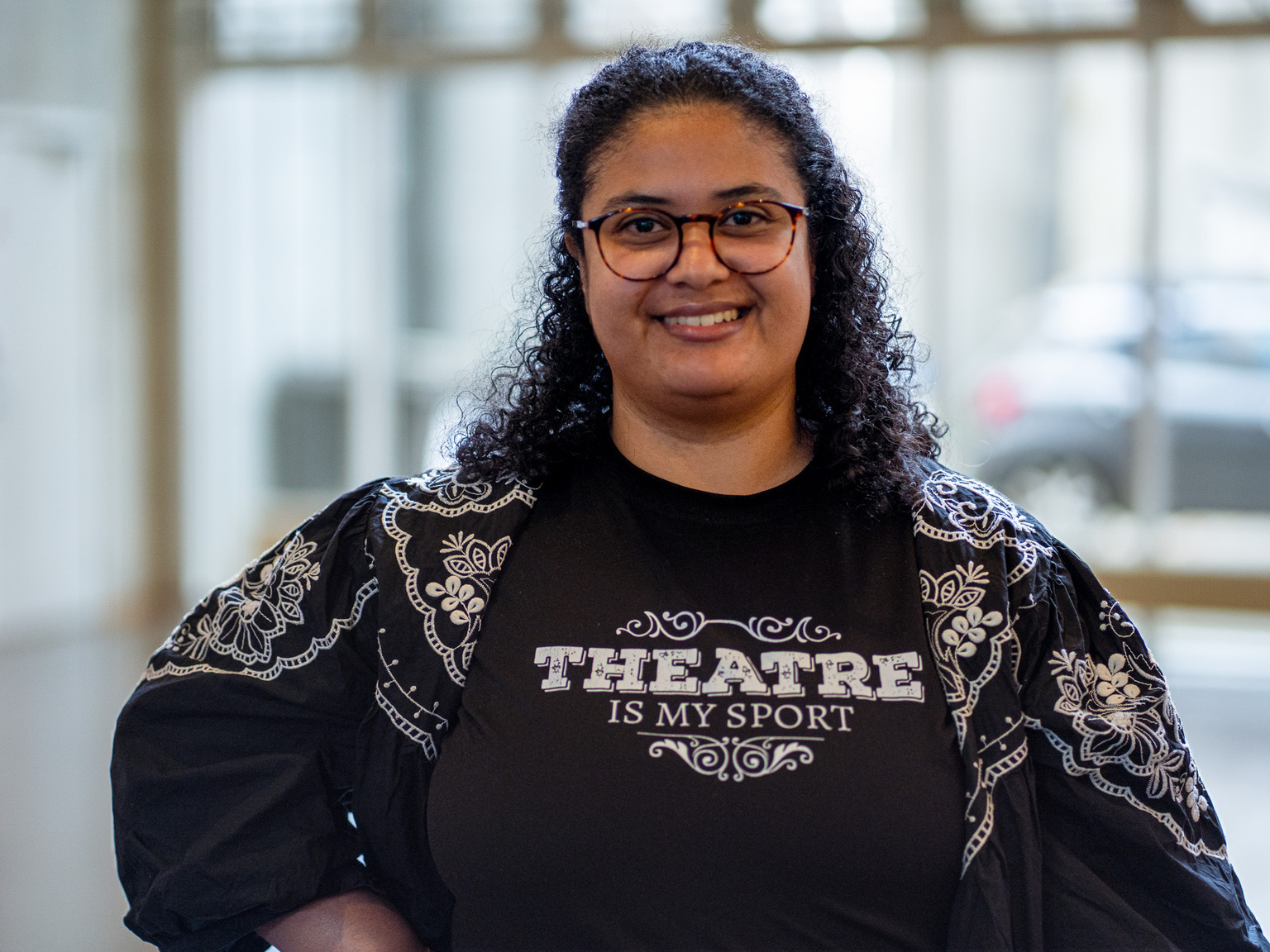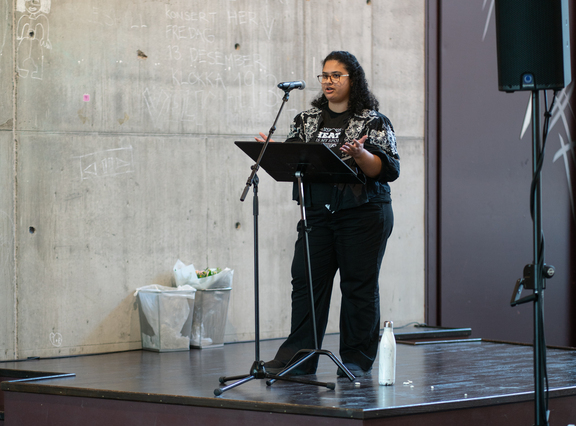
Start of studies 2025: The Student Council leader’s speech
Hello! My name is Rania Broud, and I’m the leader of the Student Council here at KHiO. I am completely new to this position, and therefore full of expectation, a little confused – a little stressed too. Maybe some of you are feeling the same thing?
Last year was my first year at KHiO – and it was completely … well, insane. I got in. I survived. I learned a whole lot. And now I’m standing here for the second year in a row, a bit wiser, a bit more self-confident. But I’m also staring directly at the big question: What now?
Because in this room we all find ourselves at different points in our journey.
Some of you are here for the very first time.
Some are in your second or third year of a Bachelor’s degree.
Some are at the beginning or middle of your Master’s degree.
But we have one thing in common: we are all new to something.
I’ve never taken the second year of the directing programme before. None of you are facing the exact same challenges you’re facing now. So in each our own way, we are all newcomers – yet again.
Within these walls we will be challenged by our various disciplines. And that means development – for better or for worse.
In addition to the academic challenges, we also have to navigate all the practical and administrative aspects. It’s not always fun, but it’s part and parcel of everyday life.
And then … outside these walls… there is chaos. It’s a world that I don’t always understand, to be honest. Here in Norway, there is a parliamentary election this year. And there are news headlines that are frightening, that are confusing, that wear us down.
And in the middle of all this, I hear people say: ‘Art can save the world.’
Can it, though?
Art certainly can’t save the world on its own.
But it can do something no other tool is capable of: it can change how we see the world, and then also how we act in it. And it can change the people who live in the world – and that is perhaps even more powerful.
Art can create space to see reality with a fresh pair of eyes. It can challenge rigid perspectives and arouse empathy – which is often the very basis for action. Facts can inform us, but art can move us. And it is our emotions that compel us to act.
Art can preserve stories in times of crisis. It can provide us with a safe space to explore dangerous or radical ideas. It can build communities, even when the rest of society is fragmented.
No, art can’t directly stop a war or bring an end to the climate crisis. But it can inspire hope. It can stir people into action. It can remind us that a different future is always possible. And maybe … maybe it is precisely through us, as artists, that such an alterative future begins.
If so, we must dare to see our own vulnerability.
We are vulnerable as the artists we already are – and we will continue to be vulnerable the day we walk out from here with our diplomas in our hands. But vulnerability is not a sign of weakness. It’s a sign that we are people who feel deeply, who dare to be open, and who therefore have the chance to create art that truly matters.
So let’s not forget:
We aren’t here just to learn an artform, but to shape how we, together, can encounter the world – and perhaps even change it.
And in order to do that, we need to practise.
One of the ways we can practise is to take part in student democracy. You don’t need experience to join. It’s enough that you have something you want to improve, change or add.
There are four of us on the Student Council, and we bear a great responsibility on behalf of our fellow students. Our job throughout this upcoming year is to listen. To listen to both complaints and requests.
And we need to practise how to fight.
We can’t be afraid of giving the complaints board some work to do. We have to dare to challenge the school’s management and staff. We have to be the students’ spokespeople – and therefore speak out when we aren’t satisfied.
I’m ready to be both loved and hated by the rector!
Because no one should be allowed to say to me – or to you – that ‘you’re taking up too much space’.
There has to a whole host of us who take up space, each in our own way, both inside and outside these walls.
We who sit on the Student Council want to challenge engrained attitudes and traditions, so that KHiO can keep up with developments in the world of art. We can’t face a rigid system without trying to move the boundaries of its walls.
It’s not just a question of opposing cutbacks and reductions. It is also about exposing unnecessary spending on bureaucracy – and instead finding practical, effective solutions that benefit staff and students alike.
For us, it is just as important to fight for the school, against the school and alongside the school – and always together with you, our dear fellow students.
If we manage to accomplish this here at KHiO, and doing it together, then at least I for my part will feel better equipped to continue the fight when we one day leave this building and take our particular tools out into the world.
That is why student democracy is so crucial.
That is why all artists must practise, in order to develop.
And that is why we are here.
And so, before I end, I would just like to remind everyone that these aren’t just grandiose words. Throughout history, art has indeed managed to change the world.
When the Norwegian artist Harriet Backer painted the quiet moments of everyday life in the late nineteenth century, she gave women a place in our art history and inspired new generations.
In the 1930s, Arnulf Øverland’s famous poem ‘You Must Not Sleep’ became a powerful warning against apathy in the face of fascism – and it still lives on today as a moral compass.
More recently, the production Ways of Seeing (2018), by Pia Maria Roll, Sara Baban, Hanan Benammar and Marius von der Fehr at the Black Box Theatre here in Oslo, demonstrated the inherent power of performing arts. It challenged boundaries, asked unsettling questions – and sparked a public debate that reached all the way into the government, and finally even into the courts.
And in Morocco, where I come from, Chaïbia Talal – who hails from the same indigenous group as I do, the Doukkaliat – overcame every social barrier in the 1960s and 1970s as an illiterate woman and self-taught artist. She went from a life as a maid and widow to winning international acclaim for her paintings, showing that art can grow forth even in places where no one believed it could – and still reach the entire world.
Today, women from Talal’s and my indigenous group are statistically the people in Morocco who most commonly take higher education. It’s as though we are making up for all of our female ancestors who weren’t able to read.
So when we sit here at KHiO, it might feel like the world out there is too big, too chaotic, too far away. But history shows us that art creates waves – and that waves can become movements.
We can be the next wave.
We can be the ones who use our words, images, bodies and sounds to highlight what it is that needs to change.
My hope is that we don’t leave here only with a diploma, but also with the courage to use our art – not just for ourselves, but for the entire community.
That we dare to see the world as it is – but also show what the world can become.
Because then, my dear fellow students, we are not just artists.
Then we are changemakers.
